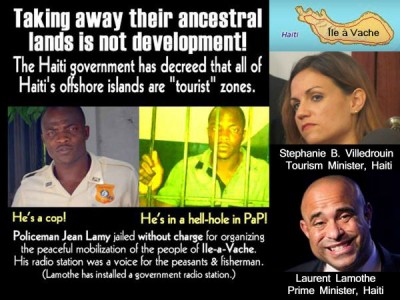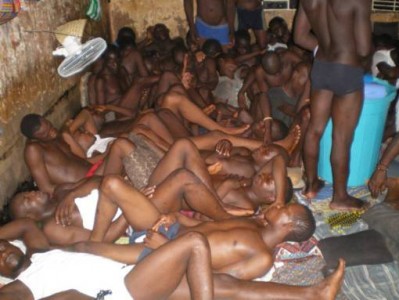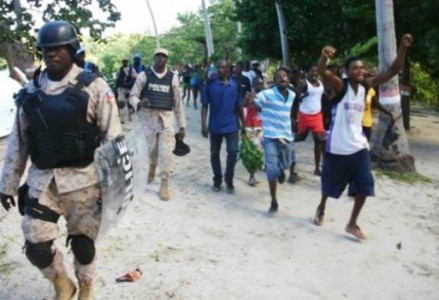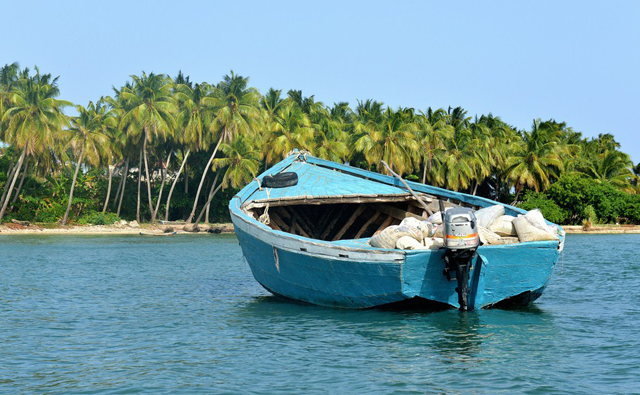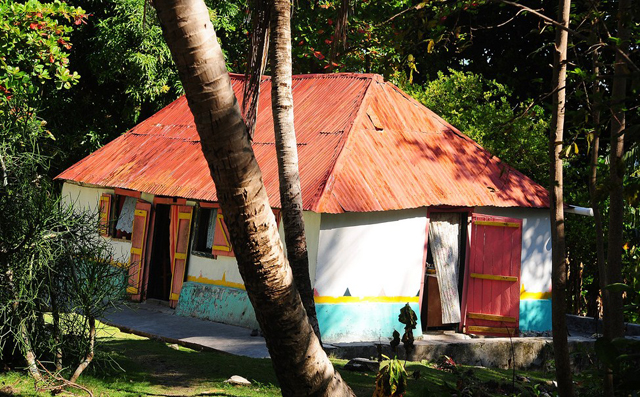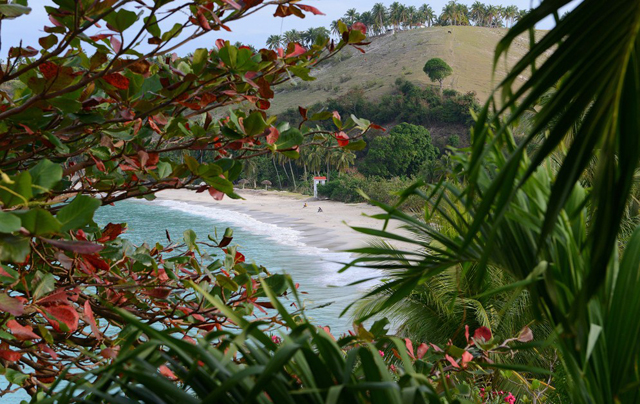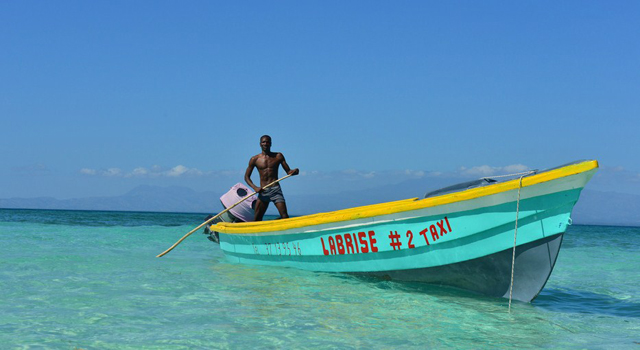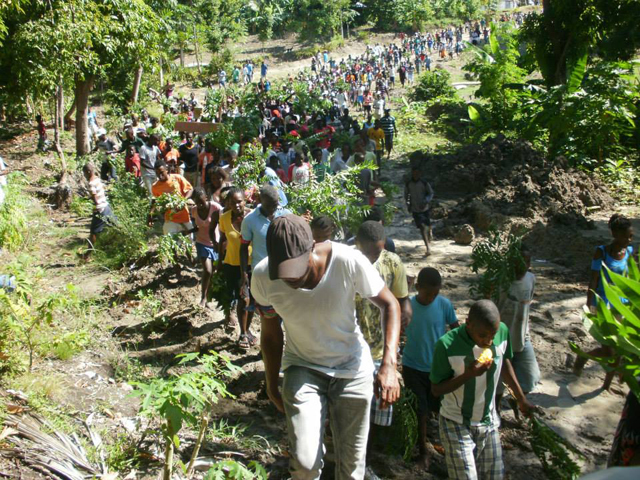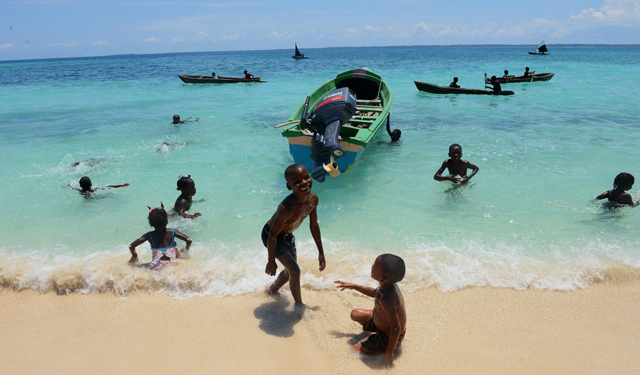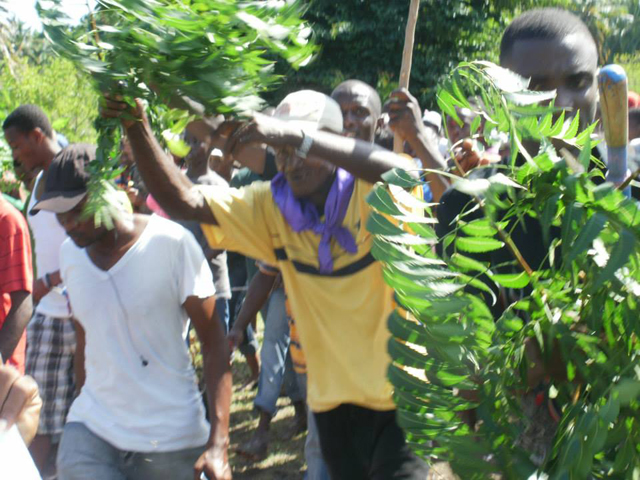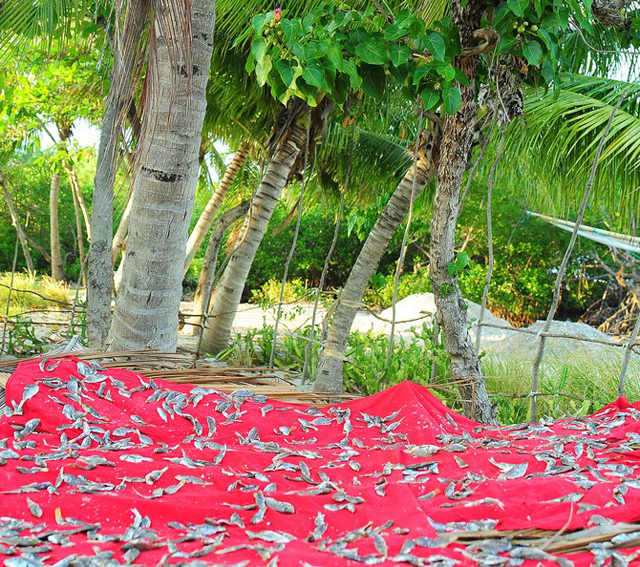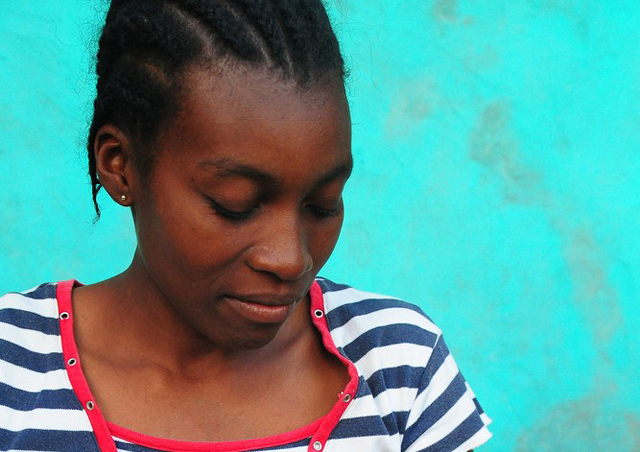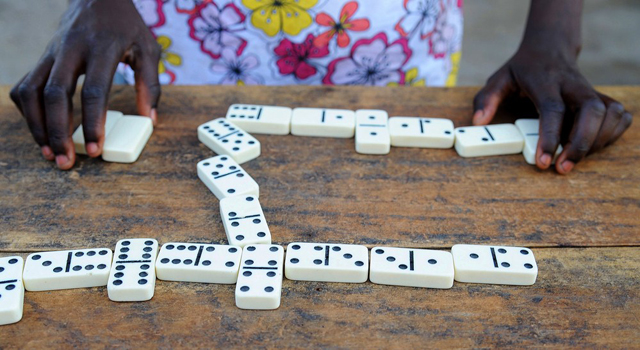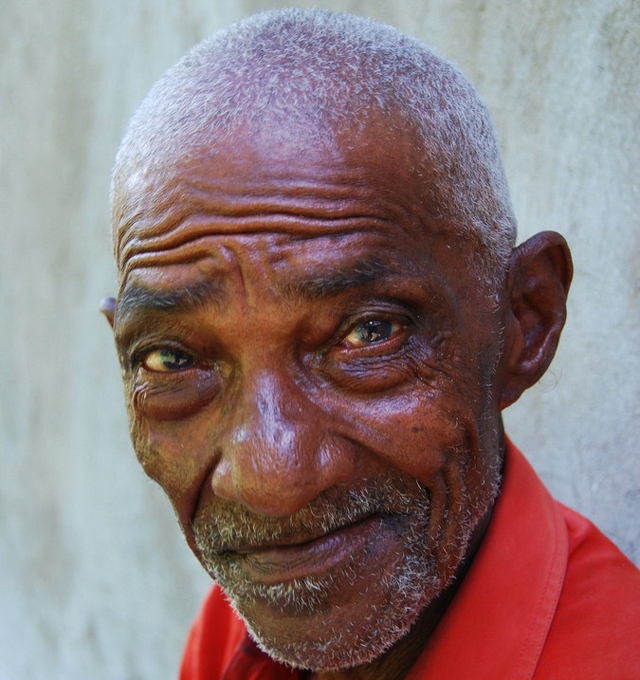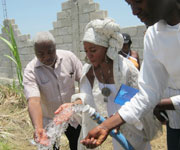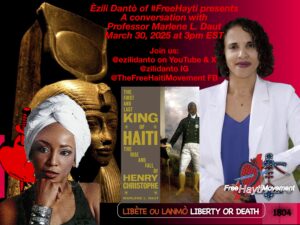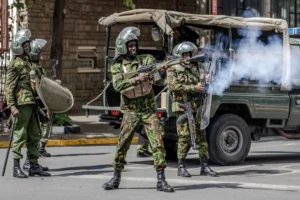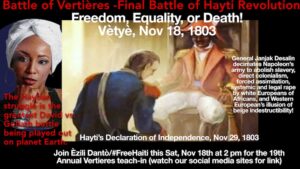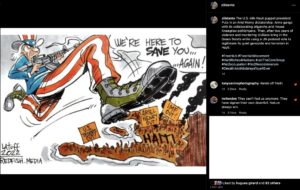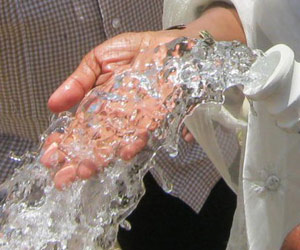In this interview, Haiti’s Jean Maltunes Lamy describes the reign of terror at Ile a Vache against the voiceless, vulnerable people there who built and reforested the island. The Ile a Vache population ask that the May 10, 2013 presidential decree making the offshore island in Haiti a zone of tourism development and public utility be rescinded. They want the unconditional release of their leader, Jean Maltunes Lamy and the withdrawal of the 115 militarized police away from the island. Check back often for further updates like this Vwa Klodi Mizo interview: Ti Pèp la di: Ilavach pap vinn tounen yon lòt Labadee. Ayiti pa pou vann! Nou pa vle yon lòt Labadee an Ayiti! (Nan emisyon sa animatè a chita sou pwoje touristik ile a vache avek manb MODEP.)
This post continues our updates on the Ile A Vache situation. Urgent action is requested, people-to-people, from world citizens. Help lift up awareness about this new earthquake in Haiti. Help stop the brutal repression and dehumanization of the people at Ile A Vache. Listen to Maltunes speak. Listen to this honorable, talented and well educated human being. Below is a picture of the National Penitentiary in Haiti where, Jean Lamy Maltunes, a policeman, husband, father, community radio station owner and well-known leader is being warehoused. Venezuela’s $27 million to Haiti tourism industry is financing, in part, Maltunes and the Ile a Vache terror.
Please circulate the voice of these voiceless Haitians under brutal imperial repression in Haiti. Help free Maltunes, get the three demands of the people met and stop the brutal repression anddispossession of the people of Ile A Vache. (For specific strategies, go to End the Left-Right White Solidarity against Haiti and Denounce Venezuela 27 million in Ile a Vache colonial project.
4 Je Kontre – 10 Mas 2014 (Kreyòl) broadcast
Jean Lamy Matulnes, the Vice President of the Gathering of Ile a Vache Farmers (Konbit Peyizan Ilavach, or KOPI) has been put in prison for the political reason of championing Ile a Vache peasant protest against the brutal right wing Haiti government’s unilaterally taking of Haiti offshore island, Ile a Vache for foreign “tourist” interests. This tourism hoax is similar to the Caracol Hoax masking foreign appropriation of fertile Haiti lands. (See also, End the Left-Right White Solidarity against Haiti by Ezili Dantò of HLLN)
The 4 Je Kontre, Jean Lamy Matulnes, Radio VKI interview is fully transcribed in Kreyòl by Franns Lwi for HLLN. This post contains an English translation of the HLLN Kreyòl transcript done by Dady Chery (part 1 and part 2) and Video translations (English/Kreyòl) from Hugues Girard.
In the landmark interview, the latest political prisoner in Haiti, Jean Lamy Maltunes speaks. Explains the history of the island and why the inequalities visited upon the people by the government land grab is a violation of their human rights, terrorizing and repulsive.
The interview was conducted by Radyo Vwa Kominote Ilavach(VKI) radio host, Sonny Esteus before Jean Lamy Matulnes was arbitrarily arrested, without charge, on February 21, 2014. The interview was broadcast March 10, 2014 with Louis Jean Gardi, and Jean Lamy Matulnes, both of Konbit-Peyizan-Ãlavach (KOPI) (Listen, also to: March 19, 2014 ; March 25, 2014 and March 27, 2014 updates from 4 Je Kontre.

Black Independence threatens White beliefs of Superiority. This explains current US occupation, plunder and pillage and why US/Euro constantly destroy and defame Haiti
Because of its enormous significance, HLLN’s Franns Louis transcribed this particular interview and we requested help with an English translation. The 4 Je Kontre interview ofMatulnes speaking, before he was jailed by the new US-supported Haiti dictatorship, documents for the Haitian public, world nations and peoples what is truly happening in Haiti under this US occupation behind the UN colonial army.
The interview was done before Jean Lamy Maltunes was silenced with imprisonment. Before, the mainstream began their whitewash reporting on the matter and the imperial divide and conquer game began in order to destroy the Ile a Vache’s population’s objection to having their lands confiscated, island taken as a tourist zone.
On April 7, 2014, Reuters finally reported on the Ile a Vache people’s story and, of course, like the Associated Press, it did a hatchet job. See from Dady Chery:Mainstream Media Discover Fight for Haiti’s Ile a Vache
(An English translation)Matulnes Speaks: Before jailed by Martelly-Lamothe Haiti dictatorship
English and Video transcription of the HLLN, Franns Lwi post.
4 Je Kontre – 10 Mas 2014 broadcast English by Dady Chery/Hugues Girard | Original Kreyòl Transcription, Travay Franns Lwi, HLLN-16 Mas 2014 is here.
-
Stop the land grab at Ile a Vache
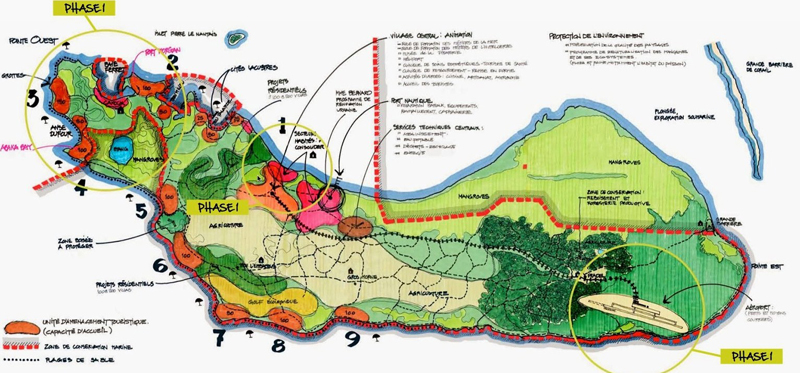
An English translation of an HLLN Kreyòl transcript – Source: Dady Chery, part 1 and part 2
Introduction
Sonny Esteus – Well, sirs, to start: what is happening on Ile a Vache today as we speak?
Jean Maltunes Lamy – Well, we can say that today the time finally came for the Ile a Vache population to see things clearly with regard to several pieces of information that have been circulating about the government’s tourism development. The population is beginning to realize that it was not included from the start, and today, work is starting. The execution of the project has started, with plenty of abuse.
SE – Louis Jean Gadi, did you see the documents for this project? What’s in this project?
Louis Jean Gadi – Based on what I’ve seen from the Tourism Minister, she”d have us believe that there’s a project to build 1,000 hotel rooms and 2,500 villas, plus an agricultural area with agricultural infrastructure. I understand that Ile a Vache has an area of [50] square kilometers. Is this project to be done on [50] square kilometers of Ile a Vache? Where will the population go? It’s all this worry that hangs over the population. Here’s why the people don’t agree to this project. The population has been living here more than a century. And now, for a project to come and throw away all the people like this, not take their needs into account. Well, then, this is what has pushed the residents to protest against this project.
SE – Jean Maltunes, what happened? Hotels, villas, agricultural infrastructure? Well, it’s development, isn”t it? I assume you’ve asked for development of the island?
| English/Kreyòl Video Translation of Jean Lamy Matulnes’ last radio interview by Hugues Girard.
Ile-a-Vache: MATULNES SPEAKS-1 Intro to Jean Lamy Matulnes’ last radio interview before he was kidnapped by the Martelly-Lamothe administration.
*** *** *** *** Check on Hugues Girard youtube for these updates.*** |
JML – Yes, it’s a dream of ours. Not only a dream, but one that would be great if we could succeed in seeing Ile a Vache become part of a worldwide tourist destination, or the most beautiful tourist destination in the Caribbean.
History of Ile a Vache
SE – Currently they say Abaka Bay is the 57th most beautiful beach in the world?
JML – Yes, I think that’s what they say. On one hand, this makes us proud, but on the other hand, what use is it? What’s the use of a cooking pot that is done cooking and then tossed out with the towel while the food is carried off. What do I mean by this? Today, all eyes are on Ile a Vache because of its green cover. Its vegetation is really beautiful. Mr. Sonny, you were on Ile a Vache, you saw that the vegetation cover was pretty good. Well, a group of people are coming from who knows where and saying they’re doing development. But they never ask themselves the question: these woods, who planted them on Ile a Vache? Was this always around on the island?
Let’s go more deeply into the history of Ile a Vache’s green cover. Ile a Vache is an island that really began to be occupied by people starting around 1930. People came here from different places. They left Saint Louis, Saint Jean, Tobec and La Trille. Why? Some came to work the land, because the land was uncultivated back then; others came to fish. Indeed, in the past, when somebody died on Ile a Vache, he was not buried there. They took his body always to Saint Jean du Sud, or Saint Louis, wherever he came from.
Around 1930, Senator Louis Desjoies comes to Ile a Vache and gets 2500 acres [800 carreaux] of land. He goes to the state and rents it from the state. He starts to plant lemongrass, lemons, millet, corn, and other agricultural crops on the island. It’s then that people begin to move to the island in large numbers. Desjoies not only pays them to plant stuff, but also gives them other small benefits. Well, even up to this point people don’t feel secure. They say: “The land is Desjoies” land, not ours.” We have to wait until 1940, when Father Robert Magron comes and builds the first city center on Ile a Vache, in La Hatte, today nicknamed Grand Cayes. It’s there that the first Catholic Church gets built. Now Father Robert Magron starts a migration, and people start to come, and Ile a Vache becomes a district of Aux Cayes.
SE – People effectively come to Ile a Vache to stay?
JML – People begin to come to live on Ile a Vache starting around this period. The first institution is a Catholic church. Well, you find, in 1957, with Francois Duvalier, one day, big trouble between him and Desjoies. Desjoies cannot hang on, and he gives up his place. Francois Duvalier leads a tough administration with dictatorial powers. He gives the Ile a Vache population the 2,500 acres from Desjoies. He takes 1,250 acres from this to give as grants to the population: as rural grants. For example, Jean Gadi Louis and me here, our fathers own lands from these rural grants. After this, 1,250 acres are still left. People are caring for these. And Ile a Vache doesn”t have only 2,500 acres of land. There’s much more land. Well, people continued to care for this.
The same government goes on to grant farming rights to people. Now Ile a Vache has three categories of land: one category is rural grants, another is farming rights, and another is people who have other land leases still in hand and who continue to cultivate. You find, starting from this point, that the Ile a Vache population plants the land with confidence. They come to feel that they own it. You see the many coconut trees and mango trees on Ile a Vache? Only two areas used to have coconut trees: Kay Kok and Trou Dlo.
I am talking now to people who know La Hatte: when you stood in Grand Cayes, the place where I said the first Catholic church was, back then you could see people fishing way down there. What I mean by this is: there were no trees. The island was not forested. Well, beginning in [the 1950s], in the places where the population got farming rights and rural grants, where they became owners, they started to plant. They came from everywhere with their plants, especially Saint Jean du Sud. This is one of the reasons why today, when you look at Ile a Vache’s vegetation cover, it’s the same as in Saint Jean du Sud. The majority of the Ile a Vache population were people who left Saint Jean du Sud with Father Robert Magron, who was a priest there. So, the vegetation cover that’s been achieved today, that has allowed Ile a Vache to catch the eyes of the world: it’s the peasants who made it. It’s the peasants who built Ile a Vache!
SE – But still they say all the islands are state lands?
LJG – [They say] all the islands are state lands, as Maltunes said. He said the government gave out grants, etc. My father has one, his father has one, all our parents have them. You see? Grants from the government to the population. And the people built this together with other folks who got farming rights from the government. These people who built this, who created all this beauty, they’re here today on Ile a Vache. How do you treat this population that has achieved this? As Maltunes said: like a pot that is done cooking. You take the food and you toss away the pot with the towel.
SE – I remember when I first met you on Ile a Vache, you used to complain that there are no roads, because even bicycles could not circulate there; people had to go on a donkey, horse, mule, or on foot. Well, but I see roads being built, and so on. What gives? Don”t you want this progress?
JML – We don’t want people to think that KOPI is protesting on Ile a Vache because we don’t want development. We want development, but we say that this development must be defined. We should be in it. For example, Mr. Sonny, after two protests on the island, KOPI gave a one-week deadline to the local authorities to give us a response. As part of this response, they asked the Tourism Minister to come to Ile a Vache.
Destruction of mangroves for ecotourism
SE – What answer did you expect [from the tourism ministry]?
JML – We expected them to explain the project that was already under way and that we knew nothing about. This is why we rose up: all the work being done. Because, consider the roads. It’s true that roads were being constructed. But the roads are being built without any plan for compensation. The airport is getting built without any plan for compensation. I feel that they took no account of the possible ecological impact. I remember in the first emission you did here, if you recall, while I was listening to that emission, how the man was saying that the mangroves function as a shield. But now they destroyed the mangroves, you see.
SE – Meaning, they deforested it.
JML – They deforested it. And many farmers have their farms on limestone. These folk went into those farms to quarry away the rocks. They wrecked the farms and they didn”t give a cent to the farmers. They gave the farmers nothing.
SE – I do remember the first broadcast I did with the young. Like you said: the mangroves on the east serve as a shield. They explained how, when there’s a hurricane, it’s the mangroves that protect the island against the strong winds from the east.
LJG – Let me say something more about this development business. It isn”t that we don’t really want development. The population must be integrated in the development being done. If you are doing a development, you should take into account all the impact on the population. If you come to an area and you say you’re doing development, and you expel the people from the area. You’re doing this development for whose profit? This is it! This is a big problem today. You see? You cannot do a development and say: “We’re developing Ile a Vache.” You say you will develop an area. You specify the area that you will develop! And then the people allow it so their lives can improve.
SE – So for you, development must consider people first?
LJG – People first.
JML – People first.
Disregard for lifestyles and traditions
SE – You were talking about the [Tourism Minister’s] response.
JML – The interim governor arranged for Minister Stephanie Balmir Villedrouin to come last Friday January 10. When she came, she confirmed that there’s no place for us here. Because, imagine this: she told us that one third of the land will be for hotels, one third for restaurants and casinos, and one third for agriculture.
SE – And the homes for everyone? Maybe they”ll be in the agricultural area. No?
JML – No. Anyone who could do the math quickly understood that we would not be in it. Secondly, when we realized that Mrs. Villedrouin said that she is taking over 12 beaches. For those who know the island, she said those 12 beaches would start from Grand Sable. From there, you follow the west coast for the 12 beaches and go south, all the way to Skannot. What troubles us about this issue is that they don’t respect our traditions. For example, not everybody knows Ile a Vache’s major holiday, but for Ile a Vache people, the patronal holiday is “Recif Careme.” Since we were children, it’s the Recif that’s been celebrated. Our holiday is “Recif Careme.” They’ve taken over that beach. It’s as if none of our rights is to be respected.
SE – Recif Careme is a beach?
JML – It is a beach. It’s there that, at Careme time, the entire Ile a Vache population goes for three to four days to celebrate Careme. Therefore, we told this to Mrs. Villedrouin, because when we asked her to come, she did come. She did not come with a written document; she came with only a map.
SE – It was an oral presentation.
JML – An ordinary oral presentation. She came with a map and simply presented us with the places that are taken. We quickly understood that we: we are not in it.
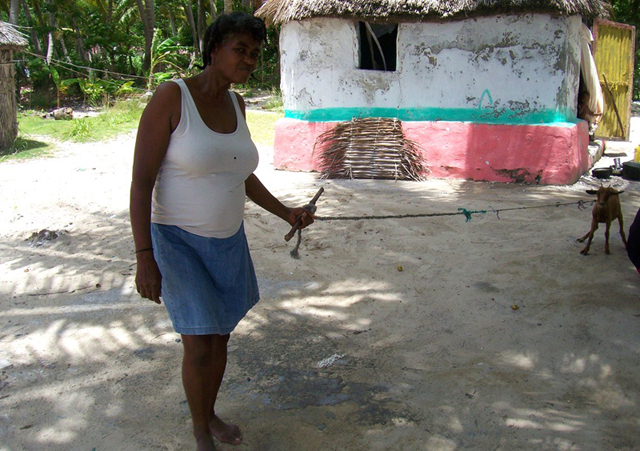 SE – Did you ask the question: and the people, where will they be put? Those who already live on the island?
SE – Did you ask the question: and the people, where will they be put? Those who already live on the island?
JML – Nowadays, they don’t talk about “displacement,” they say “relocation” and let it be understood that they will put the people in three places. And when you’re going to put people in three places, the population, we wonder about this. Even if you see us living on the island, one knowing the other, we do not have the same lifestyles. For example, you cannot take someone from the east and put him to live with someone from Betelmi, in Gros Morne. They won”t live well together.
LJG – Also, the population isn”t used to living likes this: I mean in cities, in crowds, in a series of things stacked on top of each other. People like their backyards, big yards where they keep their chickens, their goats and a whole bunch of stuff. But when you say you”ll crowd this population into a tiny city, in shelters, stuff like that, this is already exasperating. You see? Do you see how frustrating this is? It’s all this stuff that’s made the people so anxious. This population, everybody is tense. Imagine yourself at 70 or 74 years old. My father is 74. How can you tell someone who’s worked all his life to move to the city because these lands, they are needed for hotels. You see. This is not normal. This is why KOPI took up the torch to say no, to enlighten the population and have them say no, this cannot happen.
Community center, radio station and water wells, for whom?
SE – A tourism project where they will build hotels, casinos, agricultural infrastructure. But the population says it doesn”t see where it will fit in this project. Where will the people live? And this is the greatest worry of people who’ve been on the land for several decades. They worry about this project that’s already started, but with nothing said to the people who”ll be displaced about their compensation. Besides, there are already examples that worry people, with the road that has been torn through a place with many coconut trees, many mango trees that have lost their lives, and there are people’s lands they took from both sides of the road, and these people haven”t been compensated. They continue to demand compensation. And the people who”ll be displaced by the airport, etc., they worry that they won”t be compensated. Well, we know that the people took to the streets. Jean Maltunes and Louis Jean Gadi, are two leaders of KOPI (Konbit Peyizan Ilavach) who are here with us today. The Tourism Minister, who herself says that she is “the drive behind the Ile a Vache project,” she was in the area last Friday. And we learned that there was a chase. Is it then that there was this chase. The people chased after the authorities?
JML – Yes, it was right then, because this happened Thursday. The chase was not on Friday but on Thursday, when Minister Balmir tried to address the population in the public square. Thursday is market day on Ile a Vache. The people spoke, not only with Minister Balmir but also with interim governor Fritz Cesar. There were questions about 1,000 gourdes [$22] he took from people. The people were out in the sun, and they took the opportunity to bring up this problem with them.
SE – One thousand gourdes for what?
JML – He said the 1,000 gourdes [$22] are being taken from people as a deposit so they can put their goods in the market. People have still not seen where the deposit went. So they took the opportunity to bring up this issue with the interim governor. We must say that Thursday afternoon, the Secretary of State for Vegetable Production, Mr. Docent, also got a hard time from the Ile a Vache population, especially in La Hatte.
Well, along with the interim governor, these people got a hard time, along with Fernand Sajous who owns the Abaka Bay hotel. Well, these men got a hard time. Around 6:30 in the evening, they tried to meet with the people from KOPI. KOPI did not want to meet with them. But in the end, the KOPI people decided to meet them, but with the notary from the area. Well, this business ended badly because the Secretary of State stood up and said “All the land is state land. Ile a Vache is state land.” The population got mad as hell. And it’s lucky that the Secretary of State managed to leave Ile a Vache safe and sound.
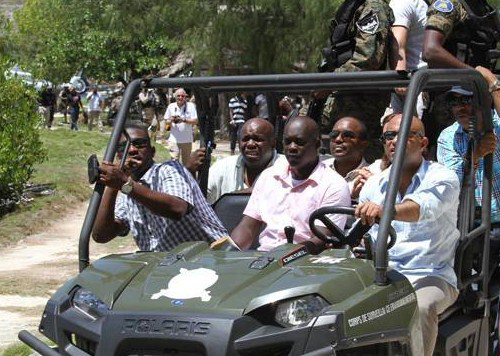
We must also tell you about the meeting that took place with Minister Balmir. The population, especially KOPI, told the Minister that she did not convince us. And naturally, we asked her to return. And she promised the population that she would return to bring us the documents. Yesterday, which was Thursday January 16, Mrs. Balmir came to the other side this time with a bigger delegation. There was a representative of DGI from Aux Cayes; the Departmental Delegate was there. In short, the meeting took place. While the meeting was going on, the population was on its feet and chanting “Ile a Vache is not for sale, not in bulk, not in retail,” and KOPI was inside. We asked her to give us the document. Unfortunately again, Mrs. Balmir [and her group], instead of giving us the document about the project, well, they talked about what they had done. For example, they said they built a community center. That’s what I”m saying: a community center. If it was for Ile a Vache people, it would be in the center of the island.
Mr. Sonny, you’ve been to Ile a Vache. A community center in Kay Kok with a library. Is this for the population? When we think about the people on the west. The Madame Bernard people: the population is better off going to Aux Cayes to go the library, instead of going down to Kay Kok. They have a radio called Vwal FM. It’s well named, because beneath a veil, anything goes. Well, this radio that’s broadcasting, no one on the island knows where it is. In other words, is this radio serving the community? No! It’s all these things: the meetings that took place, the authorities who spoke. The governor spoke one language, the secretary of state spoke another, and Minister Balmir spoke yet another. We are not clear about what is going on. We don’t know whom to believe. Today, the fight took a turn. It took a turn! We say: this kind of project, we do not want it. If they really want to develop Ile a Vache, they must revise it. They must revise this project. They’ve published a decree; this decree must be repealed.
SE – What does the decree say?
JML – The decree declared that all of Ile a Vache is a zone reserved for tourism development. We do not see a place for the population in this. They went even further and declared a maritime limit too.
LJG – And there’s something more. The project must take into account the problems of Ile a Vache. We live in this place. As you say, you’ve been to Ile a Vache. You see that there’s no potable water. You see that it lacks a lot of basic infrastructure. How are you going to do a project here? You say you’re going to do a project. And there’s no drinking water. In other words, people are living in a very difficult situation. I don’t see the value of this project.
JML – Something you left out, Jean Gadi. For example, they’re promoting the fact that, as part of this project, they”ll dig eight water wells. But today, if you go to Kay Kok, you”ll see that they dug only one well in Kay Kok, and it’s not for the Kay Kok population: it’s for Fernand Sajous, who keeps it for his hotel [Abaka Bay Resort].
LJG – And the Kay Kok population isn”t all Ile a Vache’s population. Ile a Vache has 26 neighborhoods: all 26 should benefit from these things.
Part 2- Jobs, visas, and death threats
SE – [T]he projects, up to today, based on what you see, and even what they say was done, you don’t see how the population will benefit from them?
JML – We don’t see it. Today, a major step was taken, because friends and allies gave us the details of the project. KOPI has a job it’s been doing on Ile a Vache since the Minister left yesterday. KOPI is putting this project on a big screen so that the population can see it. We must also tell you, this morning we learned about a delegation that will come to Ile a Vache: Senators Carlos Lebon, Wenceslas Lambert, together with Edo Zenny, who is president of the Senate’s Tourism Committee.
SE – But these are three partisans of power.
JML – Well, they’re the ones who”ll come. But it’s today that those senators decided to come to Ile a Vache. Here’s the problem: we were never, not one day, informed about the project. And KOPI stood up when they started to execute it. We said no. Since the island is called Ile a Vache, maybe they think only cows live here, and there’re no bulls. We had to stand up and demand an explanation. Today, we’re on the right path because Minister Balmir is changing her language to say that what she said is not what she said. You see? Governor Fritz also started to change his language today too.
Now there are threats against KOPI members. They say: they have a job for me, they have a job for Jinal, and we pay no attention. They call us on the phone. We pay no attention. They issue 17 visas for us, and we make no decision.
SE – Seventeen visas for you to go abroad?
JML – Visas for us to go away. Other things are happening: they’ve started to make anonymous phone calls to us.
SE – So, the carrot on one hand, the stick on the other.
JML – Carrot on one hand, stick on the other. Meaning, they’re making anonymous phone calls to us.
LJG – There’s something more Maltunes. It is the people who took stock of the seriousness of this project. Because the population might not have understood. Even if KOPI was doing many things, if the people were not involved, if the population was not engaged”¦ The population took stock of the problem. Now the population will not accept anything: not from the Minister, not from the government, because the population is aware of everything. And this: even before we show the projections in all the neighborhoods. This will expand the awareness of the population about the issue. The population won”t accept just anything again from them.
An 18-hole golf course for the people or the ecotourists?
SE – So you say there’s a decree that has declared Ile a Vache to be a conservation area. The work being done, for example for the airport, at what stage is it? Have they started to displace people? The people, have they already relocated them?
JML – Well, for this to be done, Mr. Sonny, they”d have to show some things, but instead they’re hiding them. If there’s a plan to displace the population, the first thing to do is to meet with the people, show them what kind of housing you’re going to give them and where. Today we must say that this wasn”t done. In Ile a Vache today, we say a big thank you to the government, because in the 21st century, instead of initiating us into a series of high-level things to allow us to develop, it is initiating us into slums. We say a big thank you for this. We, on Ile a Vache, we don’t live close to each other. We live like other people do in rural areas.
SE – This isn”t an advantage because it means people can”t get service. For example, there are problems with electricity, and so on.
JML – It’s not good. That’s correct. Now, for the population to get service, you say there’s a plan to move them. Nevertheless, you must show us the housing where you’re going to put us. Where are you taking us? You find beautiful Ile a Vache, what do you offer us in basic services? You see a big house on Ile a Vache today, Mr. Sonny, a house that has about four to five rooms. Well, it doesn”t have more than three people living in it. I don’t know if you understand. We’re not used to living on top of each other!
LJG – You’re going to cram these people who lived in five-to-six-room houses into a little house with two or three rooms. And then, another one next to it, two to three yards away. And these people are crowded. And they’re not used to crowding.
JML – There’s more. There’s an 18-hole golf course in this project. When we think about it, what’s a golf course? When we see this on television. I’ve not experienced this, but there are people who’ve traveled who’ve explained what a golf course is. What does it mean to put an 18-hole golf course on Ile a Vache? We quickly understood that we’re not in this. They won”t put us out all at once. But the places where they’re going to cram us, we won”t want to stay there. When the Minister says 12 beaches, we don’t see a little port for small boats for people who are coming from Aux Cayes. Anyway, they talk about maritime limits. Minister Balmir qualifies the nets as being criminal nets.
Goodbye locals, welcome cruise ships
SE – Nets? What do you mean by nets?
JML – Nets for fishing. She says they’re criminal nets.
SE – You’re killing small fish?
JML – We’re killing small fish [they say]. If we’re killing small fish, they should give us some limits.
LJG – If the netting is too small, we should regulate it, we could expand the netting, or they could give us other nets. The majority of Ile a Vache people live from fishing. Now, when you say you’re going to put them in this little town, and these people, these are people who did a lot of fishing.
SE – Fishermen like to live on the coast.
LJG – And they no longer have the means to fish. And they have families to care for.
SE – Maybe they could work in the hotels?
LJG – But the hotel work will be farmed out. Do these people have the experience to work in hotels?
JML – Besides, there’s a proverb that says: “You must bring the coat all the way to the door.” Today, Minister Balmir, with all this project, we got to the doorstep. And there we saw that everything you’ve said to us before was a lie.
SE – You can”t say people are liars. You can say that what they say isn”t true, but you can”t say they’re liars.
LJM – One mustn”t say someone’s a liar. What she said wasn”t true. Even today, Minister Balmir is still saying to us that we won”t be displaced. But we consider the scale of the project and can see that we”ll be displaced. Secondly, don’t forget that the decree also says that the maritime perimeter is a protected area. This means, for sure, that the small farmers, the poor, won”t be able to go out there with their small boats. Because there’s going to be a lot of room reserved for cruise ships. You see what I”m saying?
SE – For big boats?
JML – For big boats. We say: “Ile a Vache, tourist destination.” Fine! Fine. But the lives of Ile a Vache people must improve. For example, there’s another question. Thirdly, Mr. Soni, we ask: Will the population work in the hotels? But the hotels already there for decades, they haven”t hired Ile a Vache people.
SE – You mean the two hotels there?
JML – The two hotels, Port Morgan and Abaka Bay. Their workers aren”t from Ile a Vache. The project you hear that the government is doing over here, interim governor Fritz discussed on Lebo-FM. He said on Lebo-FM, in Aux Cayes: even if they’re bringing in one sac of cement, there won”t be Ile a Vache people in it. They come with their people from Petit Goave to work here. In other words, we can see it all from the way it’s starting.
SE – How do you mean Petit Goave?
JML – For example, the engineer over there, they have the right to require him to hire people from the island. But he has his own people from where he comes from that he brings in for the work. Ile a Vache people aren”t part of anything. And we must tell you, Mr. Sonny, we in Ile a Vache have a temperament that has allowed today, for the government to move in on us the way it’s moving in. We are very gentle. I believe that in all Haiti’s history, this is the first time anyone has heard of people on Ile a Vache being part of this kind of movement.
Cornered animals do bite
SE – The way you told it, what happened to the secretary of state had no docility in it. No?
JML – Well, that’s it. And that’s why things started badly. Cornered animals do bite. Today, we’re cornered. This means that we’re clear. And we want to get their attention. They’re asking for Ile a Vache land. They want to dispossess us of this land. These people must understand that, when they want to take all the peasants” lands, it’s easy for the peasants to forget all moral restraint. And, we wouldn”t wish for things to go that far. And they know that peasants are very attached to their lands. And that’s why we’re taking advantage of this on-air time to appeal to all tourists who plan to visit Ile a Vache. All the tourists can come. We have no problems. We’re very open with the tourists. Local tourists, international tourists, they can visit Ile a Vache in safety.
But the people who are doing the projects, who are running heavy machinery on the island, please, things are not yet settled. If an ambassador is listening in, a consul is listening in, things are not yet agreed on. All those who are charged with running heavy machinery for work on this project should check with their bosses and ask to stay at home, because the Ile a Vache population is watching them. Today, all Ile a Vache is blocked. There’s no school on Ile a Vache this morning, because we’re forced to watch them. We have nowhere else. To conclude: a little while ago, Gadi said that his father is 74 years old. Well, there’s somebody on Ile a Vache now who is 102 years old. Izane de la Hatte is 102 years old. She was born on Ile a Vache; her mother was called Izani. It wasn”t a thunderbolt that put us on Ile a Vache.
Peasants who know the history of development on Ile a Vache
SE – Well, we’re running out of time. Now, for you in KOPI, what would make you feel that everything’s calm, the project can start, you won”t give any more objections. What would you wish to be done to put you at ease?
LJG – Well, here’s what I”d say. And I say it for Kopi, my entire family and all the residents of Ile a Vache. The population should be integrated into this project. This project cannot be done on a scale that includes all Ile a Vache. It should pick one area. It could make a tourist area out of four, five or six neighborhoods. That depends. But the project should take into account the wishes of the population. It should not exclude the population. The population might choose to give up an area for the project. There’s no problem. But to force people to leave where they are to go live elsewhere, this isn”t good. We cannot accept this. The people won”t take this either. It isn”t because they’re peasants, because in this context I say I don’t like this business about “peasants.” I remember when I was a kid in school in Aux Cayes, and they”d treat me as a little peasant, this would hurt. You”d open your mouth in the classroom and you”d hear: “Hey, over of there, peasant! Your birth certificate says peasant!” You see? It’s as if a peasant is retarded. This I believe to be wrong. It’s as if the person lives in a primitive state. Well, this is what the Minister thinks, this is what the government also thinks, and that caused them to come with this project to put out people. For them, peasants don’t know anything. They don’t know what they’re worth. They can send them away and do anything to them. But the peasant is not like that! The peasant is not what they think!
SE – And especially today.
LJG – Yes. My father is a peasant, my mother is a peasant, my grandmother, all my grandparents, they’re all peasants. But they have something. They have wisdom. You see?
SE – They believe in dignity.
LJG – They believe in dignity. They love to work. They respect people. Well, peasants respect people because they like to be respected too. Well, what they’re doing here, it shows they’ve no respect for the peasants. If you come to put out the peasant like that and tell him “you go”: where can he go? He doesn”t know where to go. And then you take the land to build hotels. You do not respect the peasants. And the peasants like to be respected. You must respect us. That’s what I say!
SE – Maltunes?
JML – Ile a Vache has already had the experience [of development]. The owners of the Abaka Bay and Port Morgan hotels, these are people who contracted with the government and came. The population gave up the sites, and they compensated people normally.
SE – You mean the two big hotels on the island?
JML – Yes. Port Morgan did not give all these problems. Abaka Bay did not either. So they must be thinking, why is the population making all this fuss? Everybody listening: Port Morgan did not give any trouble, Abaka Bay gave no problem. Meaning, if now the population is standing up, this means that something didn”t go well. And we, today, we say this project must be revised. This project must be revised! We’re not considering agricultural farms. We don’t want this. We, the people, we say: this project, to do it, they must say, this area is for hotels, and the population will keep their homes. This way, we”ll have the means to produce.
We ask the state to help us keep the means to farm and fish. To give us a boost, to brace us, because we will be a priority of the government. For us to produce the food for the tourists who will come. We can do this. This is what integration is. This is what they must do for us today. In bulk. We ask the government to take this up again. Revise the project for us. Simultaneously they must respect our traditions. They talk about all these things they”ll do, yet they haven”t built a football [soccer] field for us on Ile a Vache. And every time somebody visits, they see that there are two teams. If you see two teams, this means a football field should be built. And we say, in the South Department, Ile a Vache is an area that has great potential for football talent. We don’t have a single club, not even in the 5th division. But this hasn”t kept us from having our young men in the national championships. Today, the best left fielder in the national championships is Kismi Francois. He is from Ile a Vache. He plays in Club Victory.
Already, we can see we’re not in it. Well, the cat owner holds the cat by the head. We hold our cats by the head. We tell them: we don’t say we’re against the project. But they must revise it. The project we saw, we’re against it. This project that plans for 12 beaches, a golf course, 1,000 hotel rooms, an airport, 2,500 villas for Venezuela, agricultural infrastructure. Well, we say: this plan, the people of Ile a Vache are against it, and they must come up with another plan for us”¦. That’s KOPI’s final word. This plan, with all this stuff, that takes no account of the Ile a Vache peasants, we ask that it be revised. If they want to do a project for us, they must come to sit with us”¦. Thank you!
SE – Well, thank you Mr. Louis Jean Gadi, thank you Mr. Jean Maltunes Lami, we hope that those concerned have heard us and will reconsider the project, starting from the positions you’ve expressed in the name of the Ile a Vache population, as represented by KOPI.
******
The entire Kreyòl transcript of the Radio VKI interview by Franns Lwi, HLLN is on our website.English by Haiti Chery, Part 1 and part 2. Check back often for updates. On April 7, 2014, Reuters finally reported on the Ile a Vache people’s story and, of course, like the Associated Press, it did a hatchet job. See from Dady Chery:Mainstream Media Discover Fight for Haiti’s Ile a Vache
**************************
End the Left-Right, Imperialist/Anti-Imperialist Solidarity Against Haiti. Circulate and share this voice of the people, hidden behind the Haiti headlines, now jailed without charge. Write to the Venezuelan embassy in Haiti; write to President Nicolas Maduro, contact Venezuelan activists; ask that Venezuela use its diplomatic power to immediately work for the release of Jean Lamy Maltunes from the Haiti National Penitentiary. Demand that Venezuela immediately stop financing the neofascist Martelly/Lamothe government in the name of “helping Haitians”. To suggests other actions to the Ezili Network to help release Maltunes, end the US occupation and the complicity of the Left-Right White Solidarity against Haiti, write to: erzilidanto@yahoo.com
*********
Other HLLN recommended posts on this land grab subject include:
End the Left-Right White Solidarity against Haiti by Ezili Dantò of HLLN
CaracolHoaxmaskingforeignappropriationoffertileHaitilands; MatulnesSpeaks:BeforejailedbyMartelly-LamotheHaitidictatorship ; FreeÃleà Vache:Pursuedbygovernmenthounddogs; Haiti Not For Sale; Tourismisnotdevelopment:Haiti,LiberateYourself! ; Gayetoupatou:KoukouwoujPouNouBlokeMasakMateli-LamòtsouPopilasyon IlavachLa ; USoccupiersinHaitiprivatizingÃleà Vache”Chroniclesofacoming
Listen, also to: March 19, 2014 ; March 25, 2014 and March 27, 2014 updates from 4 Je Kontre – (in Kreyòl ).
Add a comment:
Powered by Facebook Comments

